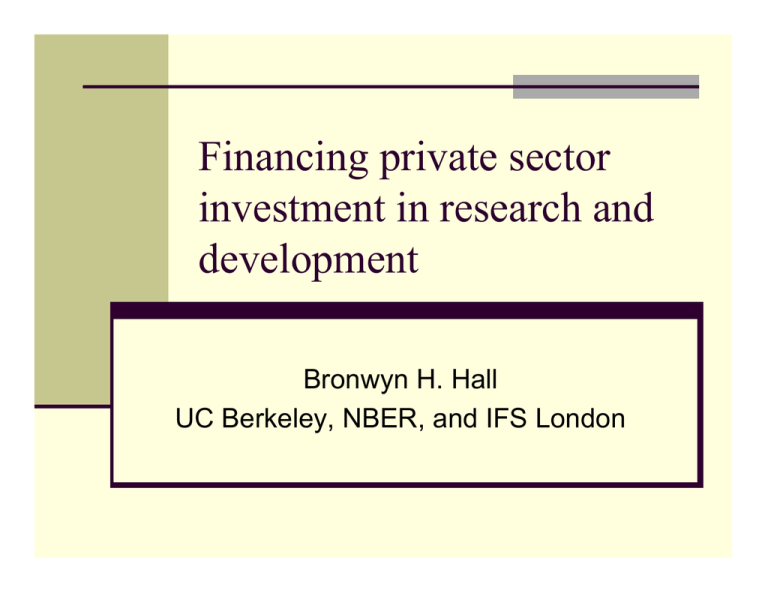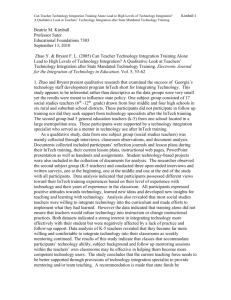Financing private sector investment in research and development Bronwyn H. Hall
advertisement

Financing private sector investment in research and development Bronwyn H. Hall UC Berkeley, NBER, and IFS London Overview Defining the issues – the economics of R&D Reasons for policy concern The R&D investment decision Financing problems and solutions Brief look at the composition of US spending Conclusions 11/28/2002 UN INTECH - Brussels 2002 2 Economics of R&D investment Competitive markets produce too little R&D (or the wrong kind) because of Positive externalities => incomplete appropriability. R&D is usually a fixed cost – the resulting imperfect competition and market power implies output in R&D industries will be below the first best level. Financing R&D is expensive because of risk, uncertainty, and asymmetric information Arrow (1962), Nelson (1959) 11/28/2002 UN INTECH - Brussels 2002 3 Economics of R&D investment BUT Competitive markets can produce too much R&D because negative externality to competitors’ R&D in a winner- take-all competition for the market One firm does not take into account the negative effect of his own R&D on other firm’s probability of success, so over-invests from society’s point of view Spence (1984), among others Empirical evidence: on balance, too little R&D, rather than too much 11/28/2002 UN INTECH - Brussels 2002 4 Private and social return to R&D Return or cost Social return S Optimal subsidy Cost (supply of funds) C Private return RC RS Level of R&D spending 11/28/2002 UN INTECH - Brussels 2002 5 Optimal subsidy varies (a) Basic Research (or generic technology) social return cost private return (b) Development (or proprietary technology) social return cost private return 11/28/2002 UN INTECH - Brussels 2002 6 Private and social cost of R&D Return or cost Social return Cost of capital S Optimal subsidy C Private return RC RS Social cost of capital RS Level of R&D spending 11/28/2002 UN INTECH - Brussels 2002 7 Characteristics of R&D investment >50% of expenditure is wages and salaries of scientists and engineers Knowledge asset created is partly tacit and embodied in their human capital; lost if they leave the firm => R&D spending tends to be smooth over time within the firm (and should be) => R&D investment behaves as though it has high adjustment costs and therefore a high required rate of return 11/28/2002 UN INTECH - Brussels 2002 8 Characteristics of R&D investment High degree of uncertainty/serendipity Especially at the beginning of a project Probability distribution of outcomes sometimes has no variance (Pareto with parameter<1) (Scherer 1998) Option value to continuation - Sometimes a project with negative expected value is worth continuing if it has a small probability of great success 11/28/2002 UN INTECH - Brussels 2002 9 The R&D investment decision Definition: user cost of R&D ρ = required pre-tax real rate of return on marginal R&D that earns r after (corporate) tax. 1− A − A ( r + δ + MAC ) ρ= 1 −τ d c Ad = value of depreciation deductions (usually=tax rate) Ac = value of tax credits, if any τ = corporate tax rate δ = depreciation rate MAC = marginal adjustment costs NB: When R&D expensed, and there are no tax credits, corporate tax rate does not enter the decision. 11/28/2002 UN INTECH - Brussels 2002 10 The R&D investment decision R&D user cost equation – factors that matter: tax treatment such as tax credits or capital gains economic depreciation or obsolescence δ sensitive to the rate of technical change in the industry, determined by such things as market structure and the rate of imitation. δ is not an invariant parameter the marginal costs of adjusting the level of the R&D program, likely to be high the investor’s required rate of return r, subject of considerable research interest – why might it be higher than for other investments? 11/28/2002 UN INTECH - Brussels 2002 11 The R&D investment decision Some reasons for high required rates of return: Insufficient appropriability Asymmetric information between owner/manager or investor/innovator Moral hazard on the part of manager or innovator 11/28/2002 UN INTECH - Brussels 2002 12 Asymmetric information in R&D lemons problem inventor/innovator cannot credibly signal the value of his invention, so in equilibrium investor requires a high rate of return Signaling or revealing the idea to reduce asymmetry also reduces the private value 11/28/2002 UN INTECH - Brussels 2002 13 Evidence on asymmetric information Various announcement effect studies that imply high rates of return associated with new R&D projects, especially when funded externally Existence of the venture capital industry, which tries to solve the problem with monitoring and non-disclosure agreements Tendency of R&D in biotechnology firms to be financed via joint ventures with pharmaceutical firms (who are able to assess project quality) 11/28/2002 UN INTECH - Brussels 2002 14 Moral hazard in R&D Two types of owner/manager conflict: manager over-invests in perks and pet projects solution is to limit free cash flow, but that raises the cost of R&D capital by forcing the firm to external capital markets Inherent conflict between need for managerial discipline and cost of external capital in R&D firms Manager tends to avoid high-risk R&D projects that diversified investor (owner) would favor 11/28/2002 UN INTECH - Brussels 2002 15 Evidence on moral hazard Anti-takeover amendments not followed by R&D cuts, or followed by R&D increases Some evidence that larger shares of institutional ownership is favorable for R&D projects – better monitoring? Magnitude of these effects, and whether they are sufficient to close the gap, unknown 11/28/2002 UN INTECH - Brussels 2002 16 Summary Asymmetric information and/or moral hazard (principal/agent conflict) imply relatively higher costs of external versus internal finance for R&D Reinforced by lack of collateral for debt finance => retained earnings important for funding R&D in established firms (Schumpeter 1956) 11/28/2002 UN INTECH - Brussels 2002 17 Some solutions R&D tax credits or subsidies for established firms Government programs that target small firms and new entrants; cost-sharing Venture capital of various types Traditional (private investor) Corporate “incubators” Government “incubators” 11/28/2002 UN INTECH - Brussels 2002 18 Government funding Many countries have programs targeted to startups and new entrants US SBIR/SBIC programs ($2B per year); ATP program ($0.2B per year) Germany – both federal and state level Sweden – investment companies, plus favorable capital gains treatment UK – enterprise companies that fund small high technology firms; guaranteed loan program for small business And so forth 11/28/2002 UN INTECH - Brussels 2002 19 Venture capital finance A partial solution to problems of asym info and moral hazard – combines strengths of market-centered and bank-centered financial systems VC contracts allocate rights to investors and innovators in complex ways (Kaplan and Stromberg 2000) More like debt when firm is doing badly (control goes to investor) More like equity when firm is doing well (control to innovator) Works best when there is an active stock market that allows early stage investors to exit by selling their shares. (Black and Gilson 1997; Rajan and Zingales 2001) 11/28/2002 UN INTECH - Brussels 2002 20 How is private sector R&D financed? US in 1996 11/28/2002 Total R&D spending $197B Industry R&D spending, of which $146B Source is industry $123B Source is federal govt., of which $23.5B Defense/space $19B Federally funded labs (energy) $2.3B Other (energy, health), of which $2B Small business programs $0.9B (avg 1994-98) Dept. of Commerce (ATP, etc) $0.2B UN INTECH - Brussels 2002 21 Conclusions Small and startup firms in R&D-intensive industries face a higher cost of capital than their larger competitors and than firms in other industries fairly clear evidence, based on theory, surveys, and empirical estimation VC solution to the problem of financing innovation has its limits: only a few sectors at one time minimum size of investment that is too large in some fields. good performance requires a thick market in small and new firm stocks (such as NASDAQ), to provide an exit strategy for early stage investors. Effectiveness of policies like government incubators, seed funding, loan guarantees, etc., deserves further study 11/28/2002 experimental or quasi-experimental setting using cross-country variation, because the outcomes may depend to a great extent on institutional factors that are difficult to control for using data from within a single country UN INTECH - Brussels 2002 22






